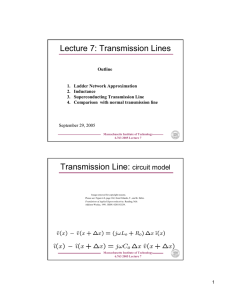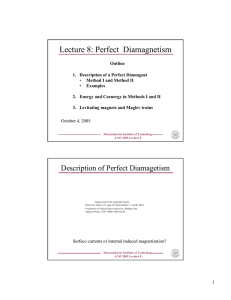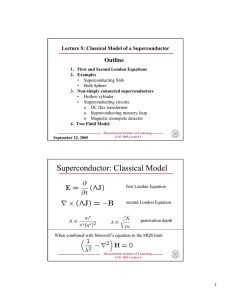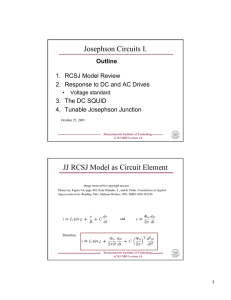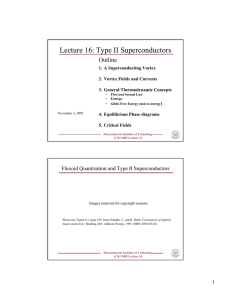Lecture 17: Flux Flow & Pinning 1. Review of Vortices 3. Pinning
advertisement
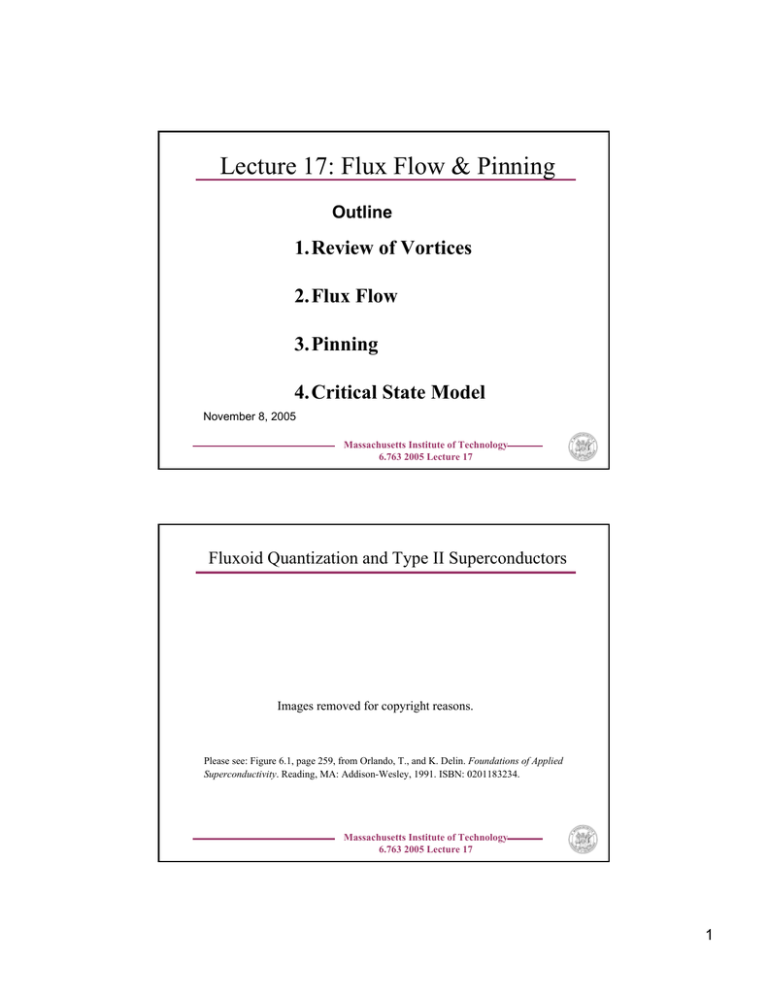
Lecture 17: Flux Flow & Pinning Outline 1. Review of Vortices 2. Flux Flow 3. Pinning 4. Critical State Model November 8, 2005 Massachusetts Institute of Technology 6.763 2005 Lecture 17 Fluxoid Quantization and Type II Superconductors Images removed for copyright reasons. Please see: Figure 6.1, page 259, from Orlando, T., and K. Delin. Foundations of Applied Superconductivity. Reading, MA: Addison-Wesley, 1991. ISBN: 0201183234. Massachusetts Institute of Technology 6.763 2005 Lecture 17 1 Vortex in a cylinder κ >> 1 z ξ Lz y φ x Images removed for copyright reasons. Please see: Figure 6.5, page 271, from Orlando, T., and K. Delin. Foundations of Applied Superconductivity. Reading, MA: Addison-Wesley, 1991. ISBN: 0201183234. Massachusetts Institute of Technology 6.763 2005 Lecture 17 The Vortex State nV is the areal density of vortices, the number per unit area. Image removed for copyright reasons. Please see: Figure 6.2a, page 262, from Orlando, T., and K. Delin. Foundations of Applied Superconductivity. Reading, MA: Addison-Wesley, 1991. ISBN: 0201183234. Image removed for copyright reasons. Please see: "A current-carrying type II superconductor in the mixed state" from http://phys.kent.edu/pages/cep.htm Massachusetts Institute of Technology 6.763 2005 Lecture 17 2 Vortices in High-Field Magnets Image removed for copyright reasons. Please see: Figure 7.7, page 353, from Orlando, T., and K. Delin. Foundations of Applied Superconductivity. Reading, MA: Addison-Wesley, 1991. ISBN: 0201183234. Image removed for copyright reasons. Please see: Figure 7.8, page 354, from Orlando, T., and K. Delin. Foundations of Applied Superconductivity. Reading, MA: Addison-Wesley, 1991. ISBN: 0201183234. Massachusetts Institute of Technology 6.763 2005 Lecture 17 Why use Type-II for Magnets? Image removed for copyright reasons. Please see: Figure 7.9, page 355, from Orlando, T., and K. Delin. Foundations of Applied Superconductivity. Reading, MA: Addison-Wesley, 1991. ISBN: 0201183234. Massachusetts Institute of Technology 6.763 2005 Lecture 17 3 Vortex Driven by a Uniform Current Currents add J > JC Currents subtract J > JC JxB Massachusetts Institute of Technology 6.763 2005 Lecture 17 Power Dissipation due to Flux Flow Let the vortices move in unison with velocity uX Faraday’s law gives a voltage in direction of current Image removed for copyright reasons. The power dissipated is then Please see: Figure 7.9b, page 355, from Orlando, T., and K. Delin. Foundations of Applied Superconductivity. Reading, MA: AddisonWesley, 1991. ISBN: 0201183234. We now seek a more microscopic description of the dissipation. This will allow us to find the velocity. So we look at one vortex to see where the power is dissipated. Massachusetts Institute of Technology 6.763 2005 Lecture 17 4 Microscopic Picture of Dissipation 2ξ Strategy: 1. 2. 3. 4. 5. 6. J in Superconductor near the core is known, J(moving vortex) Use this to find E in superconductor near the core Use continuity of E to find E inside the core J inside the core is just given by ohm’s law J = σ E All the dissipation takes place in the core as an ohmic loss. Compare this result with the previous macroscopic power to get uX Massachusetts Institute of Technology 6.763 2005 Lecture 17 Microscopic Picture of Dissipation Near the core, The electric field in the superconductor is 2ξ So that from the chain rule A little algebra gives a dipole field! Therefore, the field inside the core must be a uniform field: and Massachusetts Institute of Technology 6.763 2005 Lecture 17 5 Power dissipated in the Core Image removed for copyright reasons. Please see: Figure 7.16, page 365, from Orlando, T., and K. Delin. Foundations of Applied Superconductivity. Reading, MA: AddisonWesley, 1991. ISBN: 0201183234. The power dissipated is GL Adding the power from each vortex gives the total power dissipated Massachusetts Institute of Technology 6.763 2005 Lecture 17 Flux-Flow Resistance Macroscopic picture Microscopic picture Comparing these results gives: Therefore, we find that the power dissipated can be written as where Flux-flow resistivity Flux-flow resistivity as if current goes thru the cores Massachusetts Institute of Technology 6.763 2005 Lecture 17 6 Flux-flow viscosity Total force can be thought of as a current driving force plus a viscous drag force f’ is per unit length The forces balance in steady state, so that We found before that so that Massachusetts Institute of Technology 6.763 2005 Lecture 17 How do we keep vortices from moving and dissipating energy? Image removed for copyright reasons. Please see: "A current-carrying type II superconductor in the mixed state" from http://phys.kent.edu/pages/cep.htm Massachusetts Institute of Technology 6.763 2005 Lecture 17 7 Pinning a Vortex Image removed for copyright reasons. Please see: Figure 7.17, page 369, from Orlando, T., and K. Delin. Foundations of Applied Superconductivity. Reading, MA: Addison-Wesley, 1991. ISBN: 0201183234. a) Free energy decrease if core is in the normal region: b) Free energy core is partly in the normal region: Therefore, there is a force restraining the vortex in the normal region given by Massachusetts Institute of Technology 6.763 2005 Lecture 17 Critical Current Density When the force of the applied current density equals the pinning force, vortices move: Depinning critical current processing dependent Depairing critical current material specific Massachusetts Institute of Technology 6.763 2005 Lecture 17 8 Phase Diagram of a Type II Superconductor Image removed for copyright reasons. Please see: Phase Diagram from http://www.futurescience.com/manual/sc1000.html#C Massachusetts Institute of Technology 6.763 2005 Lecture 17 Critical State Model of Bean and Livingston Image removed for copyright reasons. Please see: Figure 7.21a, page 376, from Orlando, T., and K. Delin. Foundations of Applied Superconductivity. Reading, MA: AddisonImages Wesley, 1991. ISBN: 0201183234. Image removed for copyright reasons. removed for copyright reasons. Please see: Figure 7.21, page 376, from Orlando, T., and K. Delin. Foundations of Applied Superconductivity. Reading, MA: Addison- Wesley, 1991. ISBN: 0201183234. Please see: Figure 7.22, page 378, from Orlando, T., and K. Delin. Foundations of Applied Superconductivity. Reading, MA: AddisonWesley, 1991. ISBN: 0201183234. Massachusetts Institute of Technology 6.763 2005 Lecture 17 9 Critical State Model of Bean and Livingston Images removed for copyright reasons. Please see: Figure 7.23, page 379, from Orlando, T., and K. Delin. Foundations of Applied Superconductivity. Reading, MA: Addison-Wesley, 1991. ISBN: 0201183234. Image removed for copyright reasons. Please see: Figure 7.24, page 380, from Orlando, T., and K. Delin. Foundations of Applied Superconductivity. Reading, MA: Addison-Wesley, 1991. ISBN: 0201183234. Massachusetts Institute of Technology 6.763 2005 Lecture 17 Superconducting Wire Image removed for copyright reasons. Please see: Figure 7.26, page 383, from Orlando, T., and K. Delin. Foundations of Applied Superconductivity. Reading, MA: Addison-Wesley, 1991. ISBN: 0201183234. Massachusetts Institute of Technology 6.763 2005 Lecture 17 10
